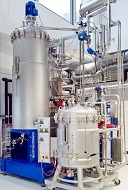
Population heterogeneity is a commonly occurring phenomenon in industrial bioprocesses, characterized by the unequal behaviour of cells of an isogenic culture. Production processes in industrial scale bioreactors often involve insufficient mixing, resulting in the formation of gradients inside the bioreactor. As a result, cells are exposed to changing microenvironments, depending on their position in the bioreactor, and react accordingly. As a consequence, a heterogeneous cell population forms in the bioreactor, which is often accompanied by a decrease in product yield and increase in byproduct formation.
The goal of this research project is to characterize and control variations in process performance during L-phenylalanine production with recombinant Escherichia coli strains in a fed-batch process caused by population heterogeneity. To physically simulate the gradients that occur in large-scale bioreactors on a laboratory scale, a two-compartment bioreactor consisting of a homogeneously mixed stirred tank bioreactor and a tubular reactor in bypass is used, where the tubular reactor is designed as a coiled flow inverter.
The formation of subpopulations will be followed in vivo using L-phenylalanine producing Escherichia coli multiple reporter strains. For this purpose, preliminary work coupled the expression of different fluorescent proteins to cellular properties in order to track cell-specific characteristics such as growth rate, general stress response, oxygen availability, and product formation at the single cell level. To measure these cell-specific characteristics in the bioprocess, an automated real-time flow cytometer will be used to monitor the property distributions in the cell population in the two-compartment bioreactor to allow appropriate process adjustments in real time.